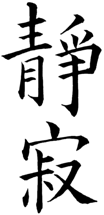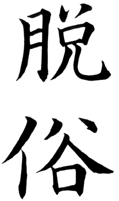Quiet Crow Bonsai
A Collection of Stellar Bonsai MusingsArticles
Shibumi Effortless Perfection
Many people might be familiar with Zen as a broad concept, far fewer are knowledgeable of the key aesthetic principles that collectively comprise the "Zen of Design." To understand the Zen of Design principles, a good starting point is shibumi. It is an overarching concept, an ideal. It has no precise definition in Japanese, but its meaning is reserved for objects and experiences that exhibit in paradox and all at once the very best of everything and nothing: Elegant simplicity; Effortless effectiveness; understated excellence; Beautiful imperfection.
Sarah Susanka defines shibumi in her 1998 book The Not So Big House: "The quality of shibumi evolves out of a process of complexity, though none of this complexity shows in the result. It often seems to arise when an architect is striving to meet a particular design challenge. When something has been designed really well, it has an understated, effortless beauty, and it really works. That’s shibumi."
The goal is not to incorporate all seven Zen principles into a given design. Your objective, rather, should be to pick those which best align with your desired outcome to guide your process and final design. The process may be complex, but these seven Zen principles can help you approach effortless perfection in your own bonsai designs
- Koko (austerity):
-
 Koko emphasizes restraint, exclusion, and omission. The goal is to present something that both appears spare and imparts a sense of focus and clarity. In creating beautiful works of Bonsai, it is inevitable that the artist’s personality and character will come across in its appearance. Much like canvas art, every trunk twist and branch will provide the audience with an insight into the artist’s soul. Strive to eliminate what is not needed in the design. It has been my experience that this element is the first and many times the most difficult to achieve for the bonsai artist. Refrain from leaving/adding what is not absolutely necessary in the first place
Koko emphasizes restraint, exclusion, and omission. The goal is to present something that both appears spare and imparts a sense of focus and clarity. In creating beautiful works of Bonsai, it is inevitable that the artist’s personality and character will come across in its appearance. Much like canvas art, every trunk twist and branch will provide the audience with an insight into the artist’s soul. Strive to eliminate what is not needed in the design. It has been my experience that this element is the first and many times the most difficult to achieve for the bonsai artist. Refrain from leaving/adding what is not absolutely necessary in the first place
- Kanso (simplicity):
-
 Kanso dictates that beauty and utility need not be overstated, overly decorative, or fanciful. The overall effect is fresh, clean, and neat. Simple is better! Less is more! Learn to eliminate the unimportant and focus on what matters within the space, resulting in a fresh, simple design. It is easy to over-complicate Bonsai design with extravagant pots and weird curves. However tempted you might be, aim to keep your Bonsai simple. In Zen philosophy, profound knowledge and thought is best expressed through simple terms. In nature, particularly Bonsai, the most beautiful trees are often the simplest. Eliminate what doesn’t matter to make more room for what does.
Kanso dictates that beauty and utility need not be overstated, overly decorative, or fanciful. The overall effect is fresh, clean, and neat. Simple is better! Less is more! Learn to eliminate the unimportant and focus on what matters within the space, resulting in a fresh, simple design. It is easy to over-complicate Bonsai design with extravagant pots and weird curves. However tempted you might be, aim to keep your Bonsai simple. In Zen philosophy, profound knowledge and thought is best expressed through simple terms. In nature, particularly Bonsai, the most beautiful trees are often the simplest. Eliminate what doesn’t matter to make more room for what does.
- Shizen (naturalness):
-
 The goal of shizen is to strike a balance between being "of nature" yet distinct from it--to be viewed as being without pretense or artifice, while seeming intentional rather than accidental or haphazard. Avoid inflicting man-made elements in your tree. Your Bonsai should be as natural as possible. Artificial looking trees that have been highly refined look silly and serve merely as ‘plastic’ plants. Incorporate naturally occurring patterns and rhythms into your design
The goal of shizen is to strike a balance between being "of nature" yet distinct from it--to be viewed as being without pretense or artifice, while seeming intentional rather than accidental or haphazard. Avoid inflicting man-made elements in your tree. Your Bonsai should be as natural as possible. Artificial looking trees that have been highly refined look silly and serve merely as ‘plastic’ plants. Incorporate naturally occurring patterns and rhythms into your design
- Yugen (subtlety):
-
 The Zen view, simply put, is that you want to evoke the power of suggestion; leave something to the imagination of your viewer. When you stare at a proud Bonsai, often you will experience feelings of mystery, spirituality, historical reflection or you will simply just appreciate its regal standing. The subtle appearance of its tiny branches and their twists and turns will subtly tell stories of its past. Zen meditation concerns the discarding of unnecessary baggage and focusing on empty space in which to grow. Limit information just enough to pique curiosity and leave something to the imagination.
The Zen view, simply put, is that you want to evoke the power of suggestion; leave something to the imagination of your viewer. When you stare at a proud Bonsai, often you will experience feelings of mystery, spirituality, historical reflection or you will simply just appreciate its regal standing. The subtle appearance of its tiny branches and their twists and turns will subtly tell stories of its past. Zen meditation concerns the discarding of unnecessary baggage and focusing on empty space in which to grow. Limit information just enough to pique curiosity and leave something to the imagination.
- Fukinsei (imperfection, asymmetry):
-
 The goal of fukinsei is to convey the symmetry of the natural world through clearly asymmetrical and incomplete renderings. The effect is that the viewer supplies the missing symmetry and participates in the creative act. Nature is not in perfect symmetry, yet the impact can be spectacular. Let go of rigidity and embrace the beauty of being perfectly imperfect, allowing others to participate in the creation process to move towards something truly innovative and unique. Asymmetry is the most fundamental characteristic of Bonsai, creating both space and visual harmony between branches, pots and foliage. Leave room for others to co-create with you; provide a platform for open innovation.
The goal of fukinsei is to convey the symmetry of the natural world through clearly asymmetrical and incomplete renderings. The effect is that the viewer supplies the missing symmetry and participates in the creative act. Nature is not in perfect symmetry, yet the impact can be spectacular. Let go of rigidity and embrace the beauty of being perfectly imperfect, allowing others to participate in the creation process to move towards something truly innovative and unique. Asymmetry is the most fundamental characteristic of Bonsai, creating both space and visual harmony between branches, pots and foliage. Leave room for others to co-create with you; provide a platform for open innovation.
- Seijaku (stillness, tranquility, solitude):
-
 The principle of seijaku emphasizes the fundamental Zen theme of emptiness, which implies an inexhaustible spirit. It is in states of active calm, tranquility, solitude, and quietude that we find the very essence of creative energy. Silent pauses in music, as well as motionlessness in dance and theater, illustrate the power of seijaku In meditation, we strive for achieving self-awareness and focus. Bonsai is a tranquil art. Bonsai and Japanese art invoke feelings of peace and quiet, even in the middle of busy cities or hectic settings. Learn to quiet your mind; designate a time and place for creative solitude.
The principle of seijaku emphasizes the fundamental Zen theme of emptiness, which implies an inexhaustible spirit. It is in states of active calm, tranquility, solitude, and quietude that we find the very essence of creative energy. Silent pauses in music, as well as motionlessness in dance and theater, illustrate the power of seijaku In meditation, we strive for achieving self-awareness and focus. Bonsai is a tranquil art. Bonsai and Japanese art invoke feelings of peace and quiet, even in the middle of busy cities or hectic settings. Learn to quiet your mind; designate a time and place for creative solitude.
- Datsuzoku (break from routine):
-
 Closely related to seijaku is the principle of datsuzoku, which signifies a break from daily routine or habit, a certain freedom from the commonplace. It involves a feeling of transcending the ordinary and conventional. The result of datsuzoku is pleasant surprise and unexpected amazement. Datsuzoku signifies a certain reprieve from convention. When a well-worn pattern is broken, creativity and resourcefulness emerge. Many of us view our bonsai with blinders on: this is the way the tree has always been and how it must always be. Even attempting to envision something different can be a huge challenge. Work to see your tree with "fresh eyes." Re-energize your creativity by taking regular "timeouts", then you will be able to find a creative resolution. If you have trouble with this, ask a trusted friend or attend an artist workshop for help. An interruptive "break" is an important part of any breakthrough design
Closely related to seijaku is the principle of datsuzoku, which signifies a break from daily routine or habit, a certain freedom from the commonplace. It involves a feeling of transcending the ordinary and conventional. The result of datsuzoku is pleasant surprise and unexpected amazement. Datsuzoku signifies a certain reprieve from convention. When a well-worn pattern is broken, creativity and resourcefulness emerge. Many of us view our bonsai with blinders on: this is the way the tree has always been and how it must always be. Even attempting to envision something different can be a huge challenge. Work to see your tree with "fresh eyes." Re-energize your creativity by taking regular "timeouts", then you will be able to find a creative resolution. If you have trouble with this, ask a trusted friend or attend an artist workshop for help. An interruptive "break" is an important part of any breakthrough design

